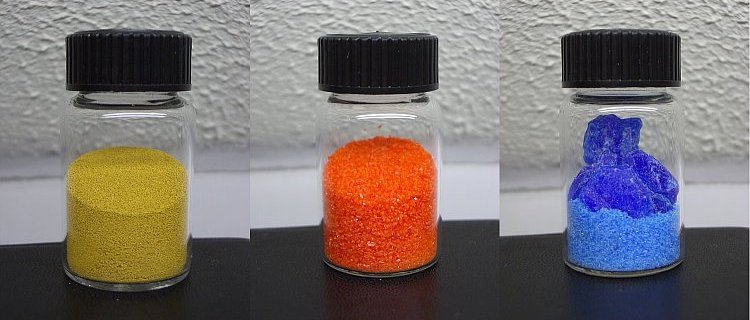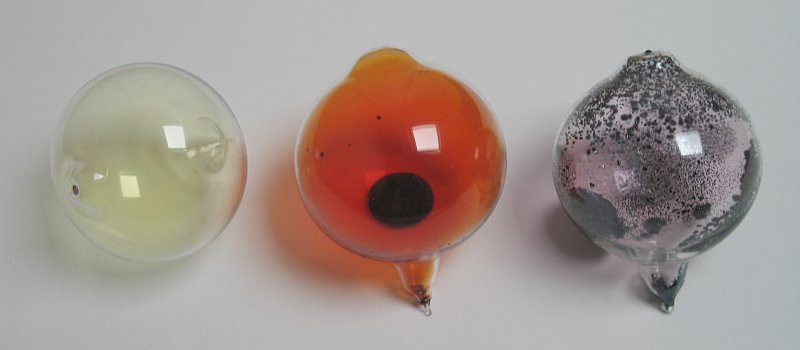


The elements from the point of view of the home chemist
As can be learned from many textbooks, the properties of the elements vary considerably, while on the other hand, there are many regular patterns to be discovered in the properties of the elements. All elements can be organized in a table, called the 'periodic table of the elements'. This site is not a textbook on the chemistry of the elements and the periodic table, but for the sake of completeness, references to some interesting info can be found here.
At this place I want to concentrate on the elements, from the point of view of the chemistry hobbyist. This section of this site emphasizes on what compounds are available for the public, and in which kinds of shops. A description is given of the available compounds and an indication is given of whether a certain compound is interesting for a home lab or not. Of course, the final choice one has to make himself, but the information, given here, may be helpful in determining where to start. The periodic table chart, given below, can be used to obtain info on compounds of specific elements. Further below, on this page, an overview is given of the different groups of elements from the point of view of the home chemist. It is remarkable how many elements are accessible for the home lab at reasonable price and which can be handled in a sufficient safe way.
| Group | 1 | 2 | 3 | 4 | 5 | 6 | 7 | 8 | 9 | 10 | 11 | 12 | 13 | 14 | 15 | 16 | 17 | 18 | |
|---|---|---|---|---|---|---|---|---|---|---|---|---|---|---|---|---|---|---|---|
| Period | |||||||||||||||||||
| 1 |
1 H |
2 He | |||||||||||||||||
| 2 |
3 Li |
4 Be |
5 B |
6 C |
7 N |
8 O |
9 F |
10 Ne | |||||||||||
| 3 |
11 Na |
12 Mg |
13 Al |
14 Si |
15 P |
16 S |
17 Cl |
18 Ar | |||||||||||
| 4 |
19 K |
20 Ca |
21 Sc |
22 Ti |
23 V |
24 Cr |
25 Mn |
26 Fe |
27 Co |
28 Ni |
29 Cu |
30 Zn |
31 Ga |
32 Ge |
33 As |
34 Se |
35 Br |
36 Kr | |
| 5 |
37 Rb |
38 Sr |
39 Y |
40 Zr |
41 Nb |
42 Mo |
43 Tc |
44 Ru |
45 Rh |
46 Pd |
47 Ag |
48 Cd |
49 In |
50 Sn |
51 Sb |
52 Te |
53 I |
54 Xe | |
| 6 |
55 Cs |
56 Ba |
* |
71 Lu |
72 Hf |
73 Ta |
74 W |
75 Re |
76 Os |
77 Ir |
78 Pt |
79 Au |
80 Hg |
81 Tl |
82 Pb |
83 Bi |
84 Po |
85 At |
86 Rn |
| 7 |
87 Fr |
88 Ra |
** |
103 Lr |
104 Rf |
105 Db |
106 Sg |
107 Bh |
108 Hs |
109 Mt |
110 Ds |
111 Rg |
112 Uub |
113 Uut |
114 Uuq |
115 Uup |
116 Uuh |
117 Uus |
118 Uuo |
| *Lanthanoids | * |
57 La |
58 Ce |
59 Pr |
60 Nd |
61 Pm |
62 Sm |
63 Eu |
64 Gd |
65 Tb |
66 Dy |
67 Ho |
68 Er |
69 Tm |
70 Yb |
||||
| **Actinoids | ** |
89 Ac |
90 Th |
91 Pa |
92 U |
93 Np |
94 Pu |
95 Am |
96 Cm |
97 Bk |
98 Cf |
99 Es |
100 Fm |
101 Md |
102 No |
||||
In the chart, some elements are made bold-face. Of these elements I, as an amateur with no connection to a chemical lab or supplier, could obtain compounds (or the element itself) without too much problems and at reasonable cost. This is a nice indication, of what the home chemist can obtain and what experimentation still is possible.
A really interesting link on the elements is http://www.seilnacht.com/Lexikon/psframe.htm. It is in German. Good texts and really good pictures of the elements. Even if you cannot read German, it is worth to spend some time on it. Alternative URL: http://www.periodensystem.net
![]()
Alkali metals and earth alkali metals
The free metals are not really interesting for the home lab, with the exception of magnesium. The alkali metals are hard to keep without oxidation and are too reactive to be used safely in a home lab. The earth alkali metals also are very susceptible to oxidation, except beryllium and magnesium. Beryllium is exceedingly toxic and many of its chemical properties (except its toxicity) are resembled by aluminium, the latter being a much better alternative for the home lab.
As mentioned already, metallic magnesium is an exception to the above. Turnings of magnesium are interesting, because they allow hydrogen to be produced easily and safely. Powdered magnesium also can be interesting in certain dry-chemical experiments, but these experiments must be carried out with more care than the average experiment.
Of course, many compounds contain an alkali metal or an earth alkali metal (especially sodium, potassium and calcium are very common), but in general the interesting properties of such compounds are determined by the anion and frequently the sodium salt and potassium salt can be exchanged without affecting the experimental outcome.
![]()
Transition metals
The transition metals form a really interesting group of elements for home experiments, which can be carried out safely. These elements can exist in varying oxidation states and frequently are very colorful, both as solids and as aqueous solutions. The gallery of compounds contains pictures of most of the compounds, mentioned below.

Transition metals also have a strong tendency to form interesting complexes with a large number of neutral molecules and many anions. The color of these complexes strongly depends on the metal and the ligand (= ion or molecule, bound to the central metal ion).
The following chemicals certainly add something to the home lab and can be obtained fairly easily (many of them are available at pottery/ceramics supply houses and photography raw chemical supply houses):
- titanium powder
- vanadium pentoxide
- chrome alum
- potassium dichromate
- manganese sulfate
- manganese dioxide
- potassium permanganate
- iron powder
- ferrous sulfate, or ferrous ammonium sulfate (Mohr's salt)
- ferric sulfate, or ferric ammonium sulfate
- ferric chloride
- potassium hexacyanoferrate (II), also known as potassium ferrocyanide
- potassium hexacyanoferrate (III), also known as potassium ferricyanide
- cobalt carbonate
- cobalt sulfate or cobalt chloride
- nickel carbonate
- nickel sulfate
- copper metal (from electrical wire or powder)
- copper carbonate (basic)
- copper sulfate
- copper chloride
- zinc metal (filings or coarse powder)
- zinc oxide
- molybdenum trioxide
- silver nitrate
As the list shows, most compounds are from the first row of the transition metals. These elements have the most interesting properties and luckily also can be obtained at low prices. Elements from the second row and third row are much more expensive. Gold chloride and palladium chloride can be purchased easily without restrictions, but for many people the price of these will be prohibitive. Sometimes these are available at eBay at $15 - $20 per gram. Silver nitrate is moderately affordable at a price tag of approximately $1 per gram.
![]() Mercury and its compounds also have quite interesting
properties, but these are very toxic and a pain to dispose of properly. For a
home lab, these are not the ones to start with.
Mercury and its compounds also have quite interesting
properties, but these are very toxic and a pain to dispose of properly. For a
home lab, these are not the ones to start with.
![]() Ultrafine iron and zinc powders should be avoided. These powders are extremely
flammable and may even be pyrophoric. For the experiments, described at this
site, it is sufficient to have medium to coarse powders (≥ 50 μm particle
size).
Ultrafine iron and zinc powders should be avoided. These powders are extremely
flammable and may even be pyrophoric. For the experiments, described at this
site, it is sufficient to have medium to coarse powders (≥ 50 μm particle
size).
![]()
Other main group metals
Of the remaining main group metals in the periodic table, only aluminium, tin, lead and bismuth are interesting for the home lab. The metals gallium and indium can be obtained fairly easily (frequently, samples of these are available on eBay), but these metals are quite pricey and their properties do not add much to a home lab, when aluminium also is available. Thallium is not available for the general public. The metal and its compounds are exceedingly toxic.
The following compounds certainly add something to a home lab:
- aluminium foil
- moderately fine aluminium powder (not the pyro stuff, like german dark etc.)
- potassium aluminium sulfate, also known as potassium alum
- tin metal
- tin (II) chloride
- lead metal
- lead acetate or lead nitrate
- bismuth metal
![]() One
must keep in mind that lead and its compounds are quite toxic. If experiments are
conducted with lead or its salts, then one must be careful. Disposal of
lead waste may be a pain, depending on what kind of waste is accepted in
domestic waste processing facilities.
One
must keep in mind that lead and its compounds are quite toxic. If experiments are
conducted with lead or its salts, then one must be careful. Disposal of
lead waste may be a pain, depending on what kind of waste is accepted in
domestic waste processing facilities.
![]() Ultrafine aluminium powders should be avoided. These powders are extremely
flammable and may even be pyrophoric. For the experiments, described at this
site, it is sufficient to have moderately fine aluminium powder.
Ultrafine aluminium powders should be avoided. These powders are extremely
flammable and may even be pyrophoric. For the experiments, described at this
site, it is sufficient to have moderately fine aluminium powder.
![]()
Metalloids
These are elements, which cannot really be regarded as metal, but which nevertheless certainly have metal-like properties, such as conduction of electricity and metallic lustre. These are the 'green elements' in the periodic table chart at the top of this page. Some people also put bismuth in this group, but most often bismuth is regarded a true metal.
The metalloids can be obtained frequently from eBay, except arsenic and polonium. However, one certainly does not need all of these elements for an interesting home lab. The following compounds can be interesting for the home lab:
- borax, also known as sodium tetraborate
- waterglass, solution of sodium silicate
- antimony
- antimony sesquioxide
Elementary boron is very inert and only can be brought to reaction at very high temperature or with extremely corrosive compounds, not suitable for home chemistry. Elementary germanium is very expensive and has properties, similar to those of silicon.
Elementary silicon and elementary tellurium may be interesting for the more advanced home chemist, but these are not the compounds to start with. Silicon is not expensive, but it is rather inert and it is difficult to perform interesting reactions with this.
![]() When experimenting with tellurium, be aware that this is
toxic and when you are exposed to this, then for a certain period of time you
are guaranteed to have a free seat in every train or bus
When experimenting with tellurium, be aware that this is
toxic and when you are exposed to this, then for a certain period of time you
are guaranteed to have a free seat in every train or bus
![]() . Even small quantities
will make you really smelly, like super-garlic!
. Even small quantities
will make you really smelly, like super-garlic!
![]()
Non-metallic elements, non-halogens
These elements can all be made or obtained without too much problems, except possibly phosphorus. For the home chemist, the following are interesting as elements. Some can be made at home, others can be purchased, either locally or through eBay.
- hydrogen
- carbon
- oxygen
- sulphur
- selenium
Much more interesting than the elements are compounds from these elements. All elements from this group, except hydrogen and oxygen, form oxo-acids. Some of these acids and salts from these acids are a must for a serious home lab. The following acids should really be available in a home lab, otherwise many interesting experiments will not be possible:
- nitric acid
- sulphuric acid
- phosphoric acid, of less importance than the other two
Of the salts of the oxo-acids, the following really should be available:
- sodium carbonate
- sodium bicarbonate
- sodium sulfite
- sodium thiosulfate
- sodium sulfide
The following are also interesting for the home lab:
- sodium (meta)bisulfite
- trisodium phosphate
- sodium sulfate
- sodium bisulfate
- sodium nitrate or potassium nitrate
- sodium nitrite or potassium nitrite
- sodium thiocyanate or potassium thiocyanate
- potassium oxalate
![]()
Halogens
The halogens chlorine, bromine and iodine are easily accessible for the chemistry hobbyist. They are volatile covalent compounds, which have nice colors in the gaseous state.

Many interesting experiments can be performed with these. The following compounds can be obtained by the general public, most of them without too much difficulty:
- sodium chloride
- hydrochloric acid
- sodium hypochlorite (bleach)
- calcium hypochlorite (swimming pool chlorine additive)
- sodium chlorate (herbicide)
- potassium chlorate
- potassium bromide
- potassium bromate
- potassium iodide
- potassium iodate
- iodine
The free halogens are quite toxic, especially bromine and chlorine, but fortunately these chemicals do not have adverse long term effects on health. The latter property makes - when done with care - experimenting with the halogens relatively safe, in spite of their reactivity and toxicity. Chlorine gas can easily be prepared, e.g. by using hypochlorite and hydrochloric acid. Aqueous bromine solutions also can easily be prepared.
Chlorides, bromides and iodides are not particularly toxic or corrosive. On their own they are not that interesting. It is the free halogens and the oxidizing compounds of the halogens, which makes experimenting with the halogens interesting. On the other hand, some complex coordination reactions also can be quite interesting. Examples of such experiments can be found in the experiments section of this site.
Chlorates, bromates and to a lesser extent iodates, must be handled with more care. These are strong oxidizers, which can form sensitive mixtures in the dry state. Chlorates and iodates are moderately toxic. Bromates probably add an additional risk. There is evidence that these are carcinogens, but there is no 100% agreement on that.
Perchlorates are less interesting from the point of view of hobby chemistry, unless your interest is geared towards pyrotechnics. Aqueous solutions of perchlorates are quite inert, in spite of the fact that perchlorate is a strong oxidizer.
A very interesting class of chemicals are the chlorine-based swimming pool chemicals. They are available in many countries at low price and high purity. Most notably are the shock-treatment chemicals calcium hypochlorite and sodium dichloroisocyanurate. The chemical trichloroisocyanuric acid (a.k.a. TCCA) is available as slow-release swimming pool chlorine in the form of tablets of 20 to 200 gram. All of these chemicals produce copious amounts of chlorine gas, when treated with hydrochloric acid.
Experimenting with fluorine or hydrogen fluoride is not feasible for the home chemist. Fluorine is extremely corrosive and hydrogen fluoride is insidiously toxic. Sodium fluoride and potassium fluoride can be obtained by the general public. From my own experience I can conclude that these two salts do not add very much to an interesting home lab. In aqueous solutions, fluorine only exists as fluoride and no interesting reactions can be carried out in the home without introducing severe risks for your health.
![]()
Inert gases
These gases are not interesting for the home lab. For very
advanced home labs, argon gas may be interesting for conducting experiments in
an inert atmosphere, but for most of us, this is out of reach
![]() .
.
![]()
Lanthanoids and actinoids
Lanthanoids can be obtained easily regularly, some of them at reasonable cost, from eBay. The free metals are quite reactive and do not keep well without protection against air and moisture. Although they can be obtained easily, these are not the ones to start with. The metals have no extensive aqueous redox chemistry and coordination chemistry like the transition metals. The metals themselves have some interesting properties as strong reductors, but when aluminium, zinc and magnesium are available then these metals do not add something really new.
A possible exception may be cerium, which has some interesting redox properties. It exists as the colorless cerium (III) ion and the deep yellow cerium (IV) yellow. Cerium (IV) is a powerful oxidizer and it is available commercially as cerium (IV) sulfate or cerium (IV) ammonium nitrate.
The actinoids, with the possible exception of thorium and depleted uranium, are not accessible for the home lab. All actinoids are radioactive and are regulated.
The only actinoids, which might be available for the public, are thorium and depleted uranium, available as thorium nitrate or thorium oxide, and uranyl nitrate or uranyl acetate. Obtaining these compounds, however, is not easy. Shipping regulations make it almost impossible to order these compounds online and if a company is willing to ship them, then the price tag probably will be prohibitive for the average home chemist.